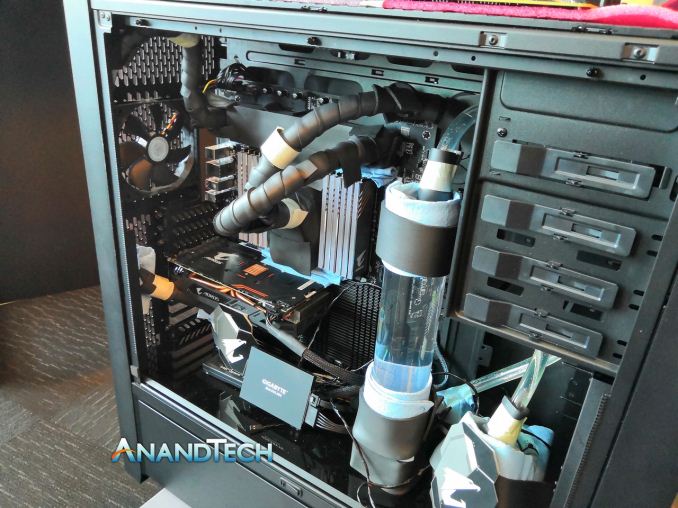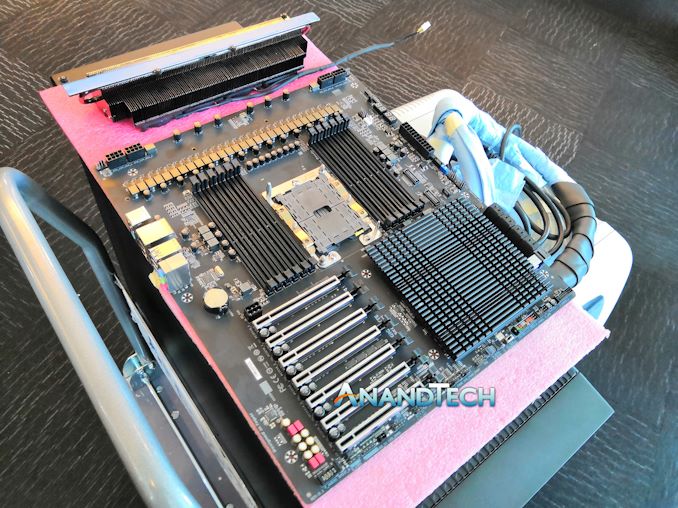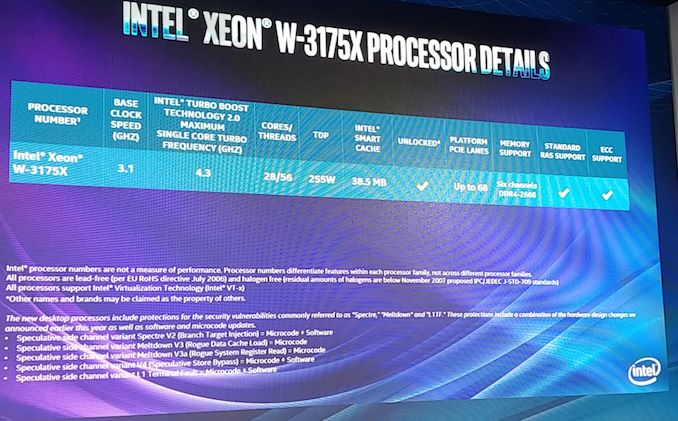The Price of Intel’s Unlocked 28-Core Xeon W-3175X: OEM Tells us ‘around $8k’
by Ian Cutress on January 6, 2019 7:25 PM EST
In perhaps a very unexpected turn of events, one of our first meetings at CES has heralded an important nugget of information. One of the boutique system integrators here at CES has told me, in conjunction with a system they are planning to ship, that Intel’s 28-core W-3175X processor will be ‘around $8k’ at retail.
In the middle of 2018, Intel announced that it would be releasing an unlocked 28-core processor, which we subsequently learned will be the Xeon W-3175X, which will have a TDP of 255W with frequencies from 3.1 GHz base to 4.3 GHz single core. It would require a new motherboard due to the six memory channels and a socket change.
We were also told that Intel is planning both 28-core and 24-core parts, and we should expect systems with the top chip and corresponding motherboards (such as ASUS’ ROG Dominus Extreme, or GIGABYTE's un-named board) to easily be in the five figure range, especially as systems with the hardware will also be paired with high-end graphics, lots of memory, and plenty of storage.
We were told by the system builder that they will expect to start shipping systems sometime in Q2, however the processors will be available before then.
If the price of $8k holds true, the chip is expensive. More reasonable estimates at the announcement were nearer $4k, because of what the CPU has to compete against. Ultimately, Intel knows that this chip will end up competing against its own Xeon Platinum 28-core parts, which already start from $8874. Because this will be a single socket part, unlocked, and have all the cores, I can totally see it eating into some of Intel’s margin of those parts. This hardware is perfect for high frequency traders who make 6 or 7 figures a day on the market – they will happily drop 5 figures on a faster machine if it means they can make more money. These chips aren’t for 99.99% of consumers at the end of the day, and I can very easily see Intel making the argument that they’re not competing against 32-core Threadripper.
We’re looking to confirm this price with other vendors, if it's with/without tax or what a boutique builder might charge to add it into the system. We know that some online retailers have starting listing parts at just over $4000, so it's an interesting disparity between the two. But we thought you should know what we’ve been told. Thoughts below!
*Images from this story were taken at Computex 2018 and Intel's August 2018 event.
Addition:
We have spoken to other people in the know, and have learned that Intel's original pricing for the chip was around $8000. One of our sources is saying that the initial documents put the price up at that high, however discussions with distributors have confirmed that the on-shelf price is more likely to be around $4500, in line with some retailer listings already out on the market. However, Intel's documents to its partners still state the $8000 price; perhaps the MSRP is that high, however retailers might be cutting into their own margins to sell the chip.












27 Comments
View All Comments
Spunjji - Monday, January 7, 2019 - link
Hell, I'd expect it to come included :DOxford Guy - Sunday, January 6, 2019 - link
"This hardware is perfect for high frequency traders who make 6 or 7 figures a day on the market – they will happily drop 5 figures on a faster machine if it means they can make more money."If they can benefit from so many cores at these lower frequencies then why not have some kind of fast networking use a lot of 5 GHz processors instead? I assume the high-frequency trading bottleneck is primarily latency. My understanding is that, more than any other market (other than possibly emulation), high-frequency traders needed high processor frequencies (combined, of course, with maximal IPC). Is the latency tradeoff from networking multiple 5 GHz systems so bad that a jumbo chip like this one is more effective?
Spunjji - Monday, January 7, 2019 - link
It's a speculative claim to say that high-frequency traders will like it, based on the tiny venn-diagram intersection of "people with enough money to buy this" and "Intel's remaining advantages over AMD".I'd like to make a more solid speculative claim: there is no market for this chip. It might find a niche being sold to people who want a "pet Xeon" and can deal without ECC support, and perhaps the odd enthusiast with too much money. Much like the supposed release for revenue of 10nm silicon, Intel are launching this so they can say they "kept" a promise, not because doing so makes any sense.
twtech - Wednesday, January 9, 2019 - link
Also, even maxed out, the W3175x is not the ultimate CPU for max clock frequency. It would be the ultimate CPU for high clockspeed with 28 cores.But what is the high-frequency trader using 28 cores for, where differences in clockspeed still matter, and getting a system with even more cores through multi-socket doesn't?
r3loaded - Monday, January 7, 2019 - link
It's purely wishful thinking. HFT traders who need this level of extreme performance and ultra low latency are already moving on to implementing their algorithms onto FPGAs.Bp_968 - Monday, January 7, 2019 - link
Nope. Look up Infiniband. Its basically designed for super low latency, super high speed networking.jordanclock - Tuesday, January 8, 2019 - link
HFT is also very space limited. It's a lot of companies competing for the same connections that are near the exchanges. Many CPUs means many boxes or larger boxes.twtech - Thursday, January 10, 2019 - link
Many CPUs maybe, but at least up to 4 CPUs it's not that hard to find reasonably-sized systems/motherboards.If the W3175x is not single-CPU limited like the rest of the W series, then it might make sense. But if it is limited to 1S configurations, then $8k is way too much. For that money, I'd rather have a pair of slightly lower-clocked 24-core regular Xeons.
twtech - Wednesday, January 9, 2019 - link
How many of those are there, really? Maybe they'll sell 100 of these CPUs.twtech - Tuesday, January 8, 2019 - link
This makes me think it was never intended to be a real product - just a diversion. Even if it is based on a $10k server chip, they must know this is too much - by a factor of about 2x.If you could dual-socket it, they might sell a few. But otherwise they'll sell almost none of them - probably by design.